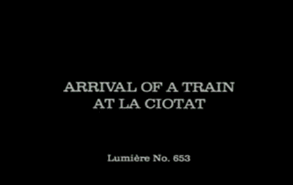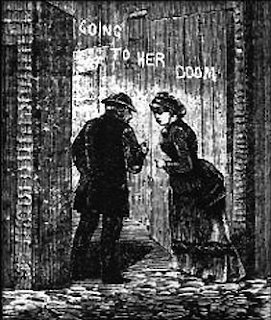THIS CHAPTER INCLUDES SPOILERS FOR THOSE WHO HAVE NOT READ UP TO CHAPTER 91
 In writing a Jack the Ripper novel, I knew that there would be some aspects of the story that I would find incredibly difficult to write. The murders are an obvious example of this but some of the sex scenes, especially those bordering on rape, proved to be equally problematic.
In writing a Jack the Ripper novel, I knew that there would be some aspects of the story that I would find incredibly difficult to write. The murders are an obvious example of this but some of the sex scenes, especially those bordering on rape, proved to be equally problematic.However, there was only one chapter that was removed completely. Not entirely for reasons of taste, but because the disturbing nature of the passage could easily be misconstrued to mean the opposite of what I intended.
The chapter in question concerned the abortion performed by Frances Tumblety on Mary Jane Kelly. There is every reason to suspect that terminating pregnancies may have been one of the very few medical procedures Dr. Tumblety was actually capable of performing, and the proliferation of rumours that Kelly was pregnant when she was murdered (yet no evidence of this was found at her autopsy) led me to conclude that perhaps she had had an abortion sometime beforehand.
Abortions were a messy, painful, nasty affair. Despite urban legends of back street terminations requiring a wire coat hanger, the procedure was more often than not carried out by injection of either a bleach or a strong alkaline through the abdomen (if the pregnancy was relatively early on).
The traumatic effects upon the womb were so intense that it rendered many women infertile (which may go some way to explain why none of the victims of Jack the Ripper had birthed any children since becoming prostitutes).
It was a brief but sensationally nasty chapter that made me wonder instantly about the limits of what I was comfortable writing. It was one thing to fictionalise historic facts on the Ripper case, it was quite another to invent such a shocking scene to make a point.
My main worry when I had finished was that this horrible account could be taken as my attempt to grandstand against abortions - the kind of fanciful, repellent tactic favoured by "pro-life" activists. In fact, I was attempting to do the opposite.
By describing, in horrible detail, the reality for women living in an age before legal abortion, my intention was to underline the importance of the procedure - and how it would still happen (albeit, more painfully and traumatically) even if it was against the law.
This small but significant about-face for me came to signify so many things about the character of Mary Jane Kelly I wanted to portray.
She is one of the greyer characters of the novel. Her intentions and actions never seem entirely noble, yet she is by no means a wicked figure. Throughout the course of the book, we trace her journey from love-struck girl - afraid of shadows and gathering mist, to desperate whore and finally, murder victim.
None of the canonical five victims are featured as much as Kelly. She is introduced in the fourth chapter of the novel and the book concludes shortly after her death. Yet, I intentionally kept her aloof. We know hardly anything about the life of Mary Jane Kelly and as such, she would remain as enigmatic a mystery on the pages of my story as she would be to history.
What is known is that she was born sometime in 1863 in Limerick, Ireland into a "well-to-do" family. She was educated and could read well. Her lover at the time of her death, Joseph Barnett claimed that she would often read aloud the newspapers for him.
By 1879, she was (alleged to be) married to a miner in Wales who died in a mine explosion. Shortly afterwards she moved to London, whereupon she all but vanishes from the record books until her death.
What is known about her comes almost entirely from the recollections of Barnett, and his truthfulness, or ability to recollect have certainly come under scrutiny over the past century and a quarter, especially as they are fraught with proven historical inaccuracies. Although, this may not necessarily be his fault, as it is quite possible that Kelly was lying to him throughout their rocky relationship.
According to him, Kelly had the nickname of "Ginger" which has led many to believe that she was a red-head but her autopsy noted that she was dark of hair - ginger was at the time seen as an exotic, exciting and expensive spice so this may go some way to explain her name - and suggest her reputation.
 At the time of her death, she had been involved in a tumultuous relationship with Barnett for over two years. The pair had continually separated over his jealousies concerning her prostitution. Barnett struggled to support them both, but his job as a market porter gave the couple very little money at all (by the time of her death, Mary Kelly was 12 weeks behind on the rent for her room).
At the time of her death, she had been involved in a tumultuous relationship with Barnett for over two years. The pair had continually separated over his jealousies concerning her prostitution. Barnett struggled to support them both, but his job as a market porter gave the couple very little money at all (by the time of her death, Mary Kelly was 12 weeks behind on the rent for her room).On the night of her murder, Mary Kelly had been seen drinking into the early hours and was singing in the street at 2AM. It is hard to ascertain precisely when she invited Jack the Ripper back to her tiny Miller's Court room, as witness reports vary - most probably owing to her being so far in debt that she had to take several men back to her home that night.
What happened to her in that little room, still remains one of the most horrifying murders in the history of the world. All the more shocking with the knowledge that whoever committed this crime, would go to his grave without ever having been caught.
Yours truly,
Charlie Revelle-Smith.





































